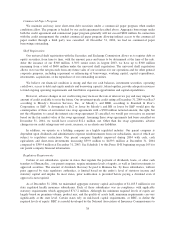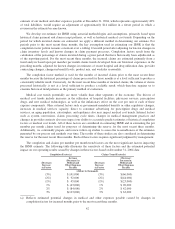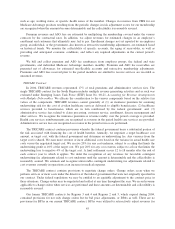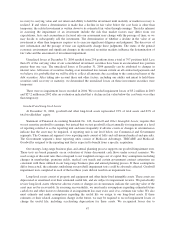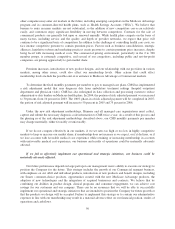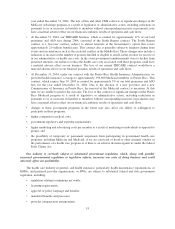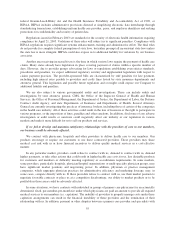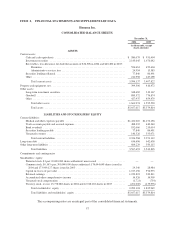Humana 2004 Annual Report Download - page 58
Download and view the complete annual report
Please find page 58 of the 2004 Humana annual report below. You can navigate through the pages in the report by either clicking on the pages listed below, or by using the keyword search tool below to find specific information within the annual report.impairment and accelerated depreciation from changes in estimated useful life of $9.3 million in 2004, $30.8
million in 2003 and $2.4 million in 2002. See Note 5 to the consolidated financial statements.
Recently Issued Accounting Pronouncements
In January 2003, the Financial Accounting Standards Board (“FASB”) issued Interpretation No. 46,
Consolidation of Variable Interest Entities, an Interpretation of ARB 51, or FIN 46. The primary objectives of
FIN 46 are to provide guidance on the identification of entities for which control is achieved through means other
than through voting rights (variable interest entities, or VIEs) and how to determine when and which business
enterprise should consolidate the VIE (the primary beneficiary). In December 2003, the FASB issued FIN 46-R,
Consolidation of Variable Interest Entities—an interpretation of ARB 51 (revised December 2003), which
amended certain provisions of FIN 46 and delayed implementation for entities that are not considered special
purpose entities until the first quarter of 2004.
As part of our ongoing business, we do not participate or knowingly seek to participate in transactions that
generate relationships with unconsolidated entities or financial partnerships, such as entities often referred to as
structured finance or SPEs, which would have been established for the purpose of facilitating off-balance sheet
arrangements or other contractually narrow or limited purposes. As of December 31, 2004, we are not involved
in any SPE transactions. The adoption of FIN 46 or FIN 46-R did not have a material impact on our financial
position, results of operations, or cash flows.
In December 2004, the FASB issued Statement No. 123R, Share-Based Payment, or Statement 123R, which
requires companies to expense the fair value of employee stock options and other forms of stock-based
compensation. This requirement represents a significant change because fixed-based stock option awards, a
predominate form of stock compensation for us, were not recognized as compensation expense under APB 25.
Statement 123R requires the cost of the award, as determined on the date of grant at fair value, be recognized
over the period during which an employee is required to provide service in exchange for the award (usually the
vesting period). The grant-date fair value of the award will be estimated using option-pricing models. We are
required to adopt Statement 123R no later than July 1, 2005 under one of three transition methods, including a
prospective, retrospective and combination approach. We disclose on page 67 the effect of expensing stock
options under a fair value approach using the Black-Scholes pricing model for 2004, 2003 and 2002. We
currently are evaluating all of the provisions of Statement 123R and the expected effect on us including, among
other items, reviewing compensation strategies related to stock-based awards, selecting an option pricing model
and determining the transition method.
In March 2004, the FASB issued EITF Issue No. 03-1, or EITF 03-1, The Meaning of Other-Than-
Temporary Impairment and its Application to Certain Investments. EITF 03-1 includes new guidance for
evaluating and recording impairment losses on certain debt and equity investments when the fair value of the
investment security is less than its carrying value. In September 2004, the FASB delayed the previously
scheduled third quarter 2004 effective date until the issuance of additional implementation guidance, expected in
2005. Upon issuance of a final standard, we will evaluate the impact on our consolidated financial position and
results of operations.
Cautionary Statements
This document includes both historical and forward-looking statements. The forward-looking statements are
made within the meaning of Section 27A of the Securities Act of 1933 and Section 21E of the Securities
Exchange Act of 1934. We intend such forward-looking statements to be covered by the safe harbor provisions
for forward-looking statements contained in the Private Securities Litigation Reform Act of 1995, and we are
including this statement for purposes of complying with these safe harbor provisions. We have based these
forward-looking statements on our current expectations and projections about future events, trends and
uncertainties. These forward-looking statements are not guarantees of future performance and are subject to risks,
uncertainties and assumptions, including, among other things, the information discussed below. In making these
48


